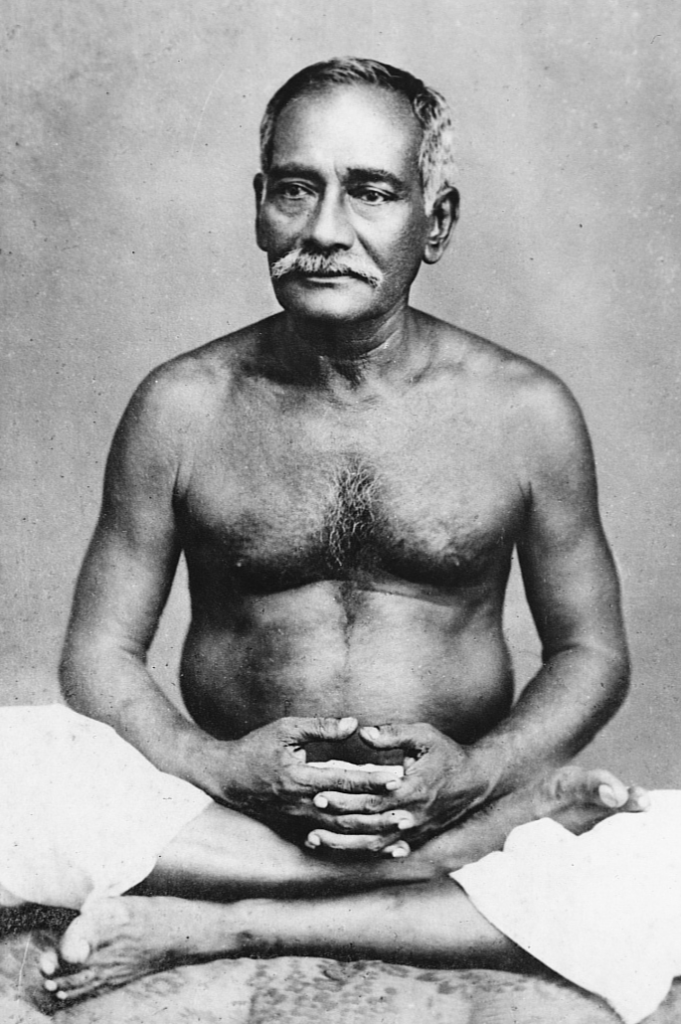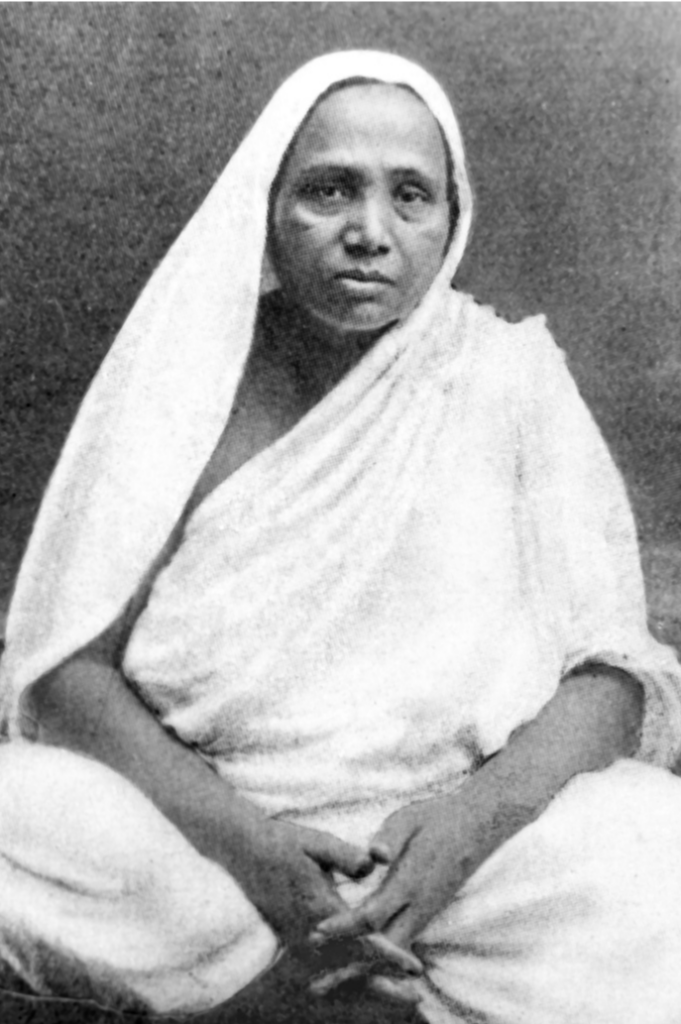- ‘Guru and Hari Are One.’
- Sri Ramakrishna is Omniscient
- ‘They Have Taken Refuge With Me’
- Swami Ambikananda
- Avatara Varisthaya
- “It Was in Her Destiny”
- Endowed With Power of Chinnamasta
- “Know How to Die”
- Kundalini Shakti Eating Food

The Master’s well-known lay disciple, of simple and cheerful nature. Born at Begampur village in Hooghly district, resident of Badurbagan, employee of a commercial firm. After deaths of first two wives married Nistarini Devi, a devotee of an extraordinarily high order. On his first visit to Dakshineswar with her, advised by the Master to take the name of God daily. Three years later, being summoned by the Master, began regular visits with wife to Dakshineswar. Fulfilling his ardent desire the Master visited his residence (5A, Brindaban Mallick Lane) with a group of devotees and going up to the first floor bestowed his grace on the waiting Nistarini. Permitted to feed the Master with her own hands, she noticed with amazement that something was emerging from within the Master coming to his lips to take the food. At Cossipore one day when she chanced to be nearby, the Master entrusted her with the care of a cat and its kitten and felt relieved. On 1.1.86 the Master told Nabagopal that he need only take the Master’s name in order to realize God. Nabagopal, thus accustomed to uttering “Sri Ramakrishna” all the time, came to be nicknamed “Sri Ramakrishna” by all and sundry. The village Ramakrishnapur in Howrah district having attracted him by its name, he bought a house there and left Badurbagan. It was in a new room of this house (81, Ramakrishnapur Lane) that on 6.2.1898, after Sushil Maharaj had completed worship of the Master, Swamiji spontaneously chanted the pranam mantra sthapakaya cha dharmasya while offering salutations to the Master in the presence of Swamis Brahmananda, Premananda, Turiyananda, Subodhananda and Adbhutananda. On 30.8.1909 Holy Mother visited the house. Nabagopal died in this house.

Third wife of the Master’s lay disciple Nabagopal Ghosh, mother of Nirad (later Swami Ambikananda), disciple of Swami Brahmananda. A pure soul, a repository fit for lofty spiritual thoughts, whom the Master considered to be an incarnation of “Chhinnamasta” (an aspect of Durga). Entranced by her first darshan of the Master, the mood lasting for six months, had the blessed opportunity to feed the Master with her own hands and perceive “something” from within his mouth snatch the food from his lips. At Cossipore the Master was much relieved after entrusting to her care a cat and its kittens which had taken shelter with him. At Vrindavan Holy Mother had a vision of Nistarini standing beside Sri Radharaman, fanning Him. After her passing Nistarini dreamt of Mother asking her to prepare “gul” (powder of burnt tobacco for teeth or gum) and take it to her (former) residence at Udbodhan. Later it was found that “gul” was missing from the offerings made to her there (Jibanaloke, p. 39). Maintained a warm relationship with the Master’s monastic disciples. Swamiji used to address her as “boudi” (sister-in-law), and Nistarini fed him “pulao” with her own hands on the occasion of his consecrating the shrine at their residence in Ramakrishnapur. Others also frequented her house, particularly when ill, when she took great care of them. Particularly fond of Swami Brahmananda whose visits to her house were occasions of great jubilation (1908, 1917, 1919, 1921). He placed a portrait of his Master in their shrine. Having attained spiritual realization through japam, blessed with the vision of her Ishta, Sri Ramchandra, and attempting to touch His feet, saw Sri Ramakrishna standing before her. At the Kashi Advaita Ashrama, Durga Puja was performed in her name in 1913. Died on 20.3.1932. Her step-son, Shyam Babu, donated Rs.40,000/- to Belur Math for the construction of a mausoleum of his guru, Swami Brahmananda.
Please bless us by installing the Master in our shrine
Swami Vivekananda arrived at the ghat of Ramakrishnapur by boat from Belur Math. He was dressed in an ochre cloth and wore a turban on his head. He was barefoot. Many people stood assembled on both sides of the road to catch a glimpse of Swamiji. He led the procession singing the famous nativity song on Sri Ramakrishna, “Who art thou laid on the lap of a poor brahmin mother?” and he himself played the khol (an earthen drum).
Navagopal and Nistarini received Swamiji with reverence and took him to the shrine. Hearing Swamiji speaking highly of all the arrangements, Nistarini said to him: “What ability do we have to worship and serve the Master? We have only a poor home and little means. Please bless us by installing the Master in our shrine.” Swamiji humorously replied: “Your Master never had in his fourteen generations such a marble-floored room to live in! He had his birth in that rural thatched cottage and passed his days without caring for comfort. And if he does not live here so excellently served, where else should he live?” Swamiji’s comment made everybody laugh. After dedicating the shrine, Swamiji extemporaneously composed the salutation mantra of Sri Ramakrishna: “I bow down to Ramakrishna, who established religion, embodying in himself the reality of all religions and being thus the foremost of Divine Incarnations.”
They Lived with God, by Swami Chetanananda
Ch 17 Navagopal Ghosh and Nistarini Ghosh, p 267
A friend had told me I should chant Haribol [repeat the name of the Lord] and I did so. But it caused great perplexity in my mind. “Here I am calling upon Hari” [a name of the Lord], I said to myself, “and yet I am told that one should seek salvation through the guru alone.” I went to Dakshineswar to see Sri Ramakrishna, but before I could explain my trouble he said to me, “The guru and Hari are one.”
One Sunday we were all at Dakshineswar. A poor woman came with four rasagollas [sweet, juicy cheese balls] for the Master, but his room was so full of devotees that she dared not enter and offer them to him. She came over to Holy Mother’s veranda [at the nahabat] and began to weep bitterly that she had come so far and now she must go away without seeing the Master. We knew too that to bring even these four rasagollas meant a great sacrifice for her. Suddenly while she was thus weeping, Sri Ramakrishna appeared on the round veranda overlooking the river. He stood for a few minutes gazing at the Ganges, and then he came down the steps and walked quickly towards Mother’s house. When he entered the veranda, he looked hither and thither as if searching for someone. Then seeing the poor woman, he went to her and said: “I am feeling very hungry. Can you give me something to eat?” The woman in great joy offered him her rasagollas. He ate all the four with evident relish and returned to his room, while she went home with her heart full of happiness.
Even animals found tender shelter with him. Once a cat took refuge in Sri Ramakrishna’s room at Dakshineswar with her three little kittens. The mother cat would sometimes sleep on his bed near his feet, and if he reached down and touched her with his hand, at once she would get up and seem almost to make a pranam [salute him]. It greatly troubled the Master to know what to do with the cat and her kittens, for he felt that they did not get proper food at the temple. So one day when I came to see him, he asked me, “Will you do something for me?” I clasped my hands before him and said, “Whatever it is, that I must do.” But again he asked and I replied as before. Then he told me of the cats and asked me to take them. “Remember,” he said, “that they have taken refuge with me, so see that they get the best of care.”
I took them home and whenever I went to the temple he would question me in every detail about the cats: Were they getting proper food? Had the kittens grown? What did I mean to do with them? He was much concerned lest I might give them away to someone who would not treat them kindly, and again he would remind me, “Remember, they took refuge with me.” The mother cat never had another family. At the end of a year she was suddenly taken ill and died. As she was dying I poured Ganges water into her mouth and repeated Sri Ramakrishna’s name.
At Cossipore garden he asked me again why I came to him. “You have children. You have jewels and furniture. Why then do you want to come to me?” I replied: “I do not want all these things. I come because I love you, because I want you. I want your blessing.” At once he went into samadhi, and as he came out of it he put his hand on my head and blessed me.
Once I carried some sweets to Sri Ramakrishna at Cossipore. As I stood hesitatingly before him, he asked, “What do you want?” “I want to give you some sweets,” I said. “Very well!” and he let me put some in his mouth. Still I stood before him. “Are you satisfied?” he asked. “No? Then what do you want?” I clasped my hands and answered, “I want to give you more sweets.” He let me put a little more in his mouth, and seeing me still unsatisfied, he asked the question a third time. When again I asked to feed him, he said: “No, no more now. Wait. In my sukshma sharira [subtle body] I shall take all the sweets you and everyone can offer me.”
Once I went to the Cossipore garden, but I found so many visitors there that I could not go upstairs. I waited for some time and then Sri Ramakrishna sent down one of his photographs, saying, “Tell her to be content with looking at this today.” Later he told me, referring to the picture, that it “would travel in railway carriages and on ocean steamers and by bearers. And people would carry it in their pockets and even on their watch chains.”
— Nistarini Ghosh (Source: Master as We Saw Him)